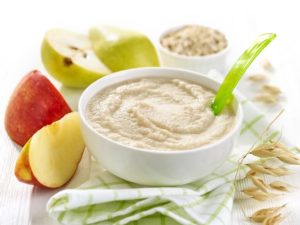In the first year of life, a nutrition plan for the baby can help with the nutrition of your child. This is because nutrition plays a key role in healthy development. Only if your baby can absorb all the nutrients it needs from the food it eats can it grow and thrive. But what should such a nutrition plan look like?
Creating a nutrition plan for a baby is easier than you think. With our tips on nutrition and complementary feeding, the transition from an exclusive milk diet to other foods is a success – check it out now!
Table of contents
This Is Why A Nutrition Plan For The Baby Makes Sense
A feeding plan for a baby may seem excessive at first. After breastfeeding or the bottle comes the complementary food, then solid food, right? But in practice, the transitions from one diet to another and the introduction of new foods are not so easy.
A plan can help you structure your child’s diet and keep all the steps in order. When it comes to the question of whether and when which meals should be given, many mothers are unsure and don’t want to do anything wrong. Our tips for the complementary feeding plan and nutrition plan for the baby will help you to find your way through the nutrition jungle.
Adapt The Feeding Plan To Age And Development Phases
The nutrition plan for the baby should always be based on its age and development phases. No two children are the same. Some babies show interest in complementary food or even solid food at an early age, others are fully breastfed for many months.
If you want to create a feeding plan for a baby, use it as a guide for your daily life at home. But don’t tie yourself tightly to the baby feeding plan if it doesn’t make sense in practice.
Below you will find tips on how to design the nutrition plan for the baby in the different months of life until the first birthday.

Feeding Plan For Months 1 To 4 Of Life
In the first months of your baby’s life, you always have the best nutrition with you: breast milk. Breastfeeding gives your baby the best of nutrients in the first weeks and months, as well as attention and physical closeness. At the same time, breast milk strengthens your child’s immune system. This is not the only reason why breastfeeding is recommended by experts.
The fascinating thing about breast milk is that its composition adapts to the respective developmental phases of the child. The amount of milk produced in the breast can also change.
If the child drinks frequently, more milk is produced. If it drinks less frequently, the amount decreases. The recommended total amount of milk for a baby to drink throughout the day is about 1/6 of the baby’s body weight. If your baby weighs five kilos, you can expect to drink a good 830 ml.
If you can’t or don’t want to breastfeed, you can find very good baby food on the market that provides your child with optimal nutrients. By giving your baby a bottle in your arms, you have your baby very close to you, similar to breastfeeding, and can give him attention. As a rule, infants are fed with initial milk, the so-called pre.
It is most similar to breast milk in its individual components. As an alternative for the first year of life, there is also 1 as initial milk with a higher starch content. It is thicker and more satisfying.
When you can use which milk formula in your baby’s nutrition plan should be discussed individually with your pediatrician. He or she has an eye on the development, size, and weight of your child and can also advise you on HA, the special milk for babies at risk of allergies.
Food other than formula is not recommended for a baby’s diet during the first four months of life. Neither are babies able to eat solid food nor is their digestion ready. At the earliest, starting with complementary food in the feeding plan is recommended from the 5th month.
How Often Should The Child Drink Milk?
Opinions differ on the subject of milk meals and the amount a baby should drink. Doctors and midwives often recommend feeding on demand, where you prepare a bottle or feed your baby whenever he or she is hungry.
Especially in the first weeks of life, drinking milk is one of your baby’s basic needs. Therefore, giving a fixed feeding plan for the baby during the period of exclusive milk feeding does not make much sense. In the early stages, a baby may well want to drink up to twelve times a day.
Once a breastfeeding or bottle-feeding rhythm has become established, some mothers try to extend the phases between the individual milk meals somewhat. On the one hand, this has the advantage that nights can be a little quieter.
Some babies also get used to increase the amount they drink during a milk meal and no longer have to eat many small meals. However, there will always be phases in which your baby clusters, i.e. wants to drink more frequently.
Feeding Plan For The Baby From The 5th Month Of Life Onwards
If your baby takes part in family meals, you may notice that he or she is keeping a close eye on what the grown-ups are eating. At the latest then, when not only the eyes follow the food of the others, but also the hands, you can think about the topic of the nutrition plan and complementary feeding plan.
Also, after a certain month of life, some children are no longer satisfied with milk food alone. Your pediatrician can also tell you whether your baby is ready for porridge and other foods.
Supplementary food should always be introduced gradually and with individual meals. A prerequisite for feeding porridge is that your child can hold its head upright on its own and is interested in new foods.
Beikost is already according to the name an additional food, which can be established next to the milk food more and more. You should therefore take your time with the introduction and the complementary feeding plan. There is no reason to quickly change your baby’s diet to foods other than breast milk or formula.
The First Porridge For Your Baby
For the first complementary food, a simple vegetable porridge is usually recommended, which you can easily prepare yourself at home. The first porridge in the feeding plan should always consist of only one vegetable.
Particularly suitable for this are:
- Carrot
- Parsnip
- Sweet potato
- Potato
- Pumpkin
If you want to make baby porridge yourself, pay attention to organic quality and do not use salt or spices in the preparation. For the first porridge in the nutrition plan for babies, simply peel the vegetables, cut them into small pieces and boil or steam them with a little water, then puree them finely.
Because your child will certainly not eat large quantities of porridge at the beginning, you can freeze baby porridge and defrost it again when needed. If you’re in a hurry, jarred food is also no problem.
If you want to feed your baby porridge for the first time, it’s best to do this on your lap or in a suitable seat, where he or she would otherwise sit at the family table. A few spoons are enough for the first attempt, because adding porridge to the baby’s diet is a big step for the little ones, and not just in terms of taste.
Eating from a spoon and swallowing also needs to be learned. After the first porridge meal, feed as usual with breast milk or a bottle. Even if the first attempts are not yet crowned with success – offer your baby the same type of vegetable for several days. Children often have to taste a food many times before they develop a taste for it.
The first porridge is often given at lunchtime. However, there is nothing to be said against introducing complementary foods in the afternoon or evening. An initial complementary feeding schedule can look like this:
- In the morning: breastfeeding/bottle.
- Morning: breastfeeding/bottle as needed.
- Midday: vegetable porridge + breastfeeding/bottle as needed.
- Afternoon: breastfeeding/bottle.
- Evening: Breastfeeding/bottle.
Add nighttime breastfeeding or bottle feeding.
Make The First Porridge A Menu
If your baby does well with the vegetable porridge, you can gradually introduce other foods into the feeding plan. One option is to combine a second vegetable. Another option is to cook lean meat, puree it and add it to the porridge.
It contains important iron for your child. A little rapeseed oil rounds off the meal as a valuable energy supplier.
Nutrition Plan For The Baby From The 6th Month Of Life
If your baby is 6 months old and copes well with the vegetable-meat porridge, you can gradually introduce other foods into the nutrition plan for the baby. Fish, given once a week, covers important nutrients that your child needs now. But also cereals and fruits can be integrated into the baby’s diet now.
The Second Porridge For Your Baby
The next porridge in the feeding plan can now be a milk-cereal porridge with some fruit puree mixed in. You can mix such a porridge for the complementary feeding plan yourself with whole milk or offer it ready-made from a jar.
Together with the fruit component, it tastes particularly good to many children. Pears or apples are suitable fruit varieties, but a baby who is 6 months old will also find bananas delicious.
You may also notice that your baby eats the afternoon porridge much better than the vegetable porridge at lunchtime. By the way: Once the little eater has devoured his portion, you don’t necessarily have to give him additional milk. Still, water and unsweetened teas quench thirst and minimize the risk of overfeeding.
The second porridge in the feeding plan is usually fed in the afternoon or evening. Over the course of the day, the complementary feeding plan can look like this:
- Morning: breastfeeding/bottle.
- In the morning: breastfeeding/bottle as needed.
- Midday: Vegetable-meat porridge + water/tea.
- Afternoon: Breastfeeding/bottle.
- Evening: Milk-cereal porridge + water/tea.
At bedtime, you will almost certainly want to give another bottle or breastfeed your baby.
Feeding Plan For The Baby From 7 Months Of Age
If your baby is not 6 months old anymore, a third porridge can be integrated into the complementary feeding plan. The dairy-free cereal-fruit porridge is ideal for the afternoon and is usually eaten with pleasure. Here you can also experiment with different types of fruit.
If you don’t want to boil down and puree everything yourself, you can fall back on a large selection of fruit jars from the shops. However, whole-grain cereal flakes or semolina boiled up with water, serve as the basis.
In addition, some fruit puree and rapeseed oil are stirred in. If the porridge is well accepted in the complementary feeding plan, you no longer need to bottle feed or breastfeed in the afternoon.
Our tip for your baby’s complementary feeding plan from 7 months:
- In the morning: breastfeeding/bottle.
- In the morning: breastfeeding/bottle as needed.
- Lunchtime: Vegetable-meat porridge + water/tea.
- Afternoon: Cereal-fruit porridge + water/tea.
- Evening: Milk-cereal porridge + water/tea.
Feeding Plan For The Baby From 8 Months Of Age
When your baby is 8 months old, the same fruit-cereal porridge as in the afternoon can also be given in the morning. This means that there are now four porridges on the complementary feeding plan and breastfeeding or bottle-feeding is reduced to mornings, nights, and when the baby goes to sleep.
At 8 months of age, you can slowly get your baby used to eat more chunky foods. By the way, this is possible even if there are no teeth yet! Soft vegetable and fruit pieces are simply mashed on the palate with the tongue.
To add texture to porridges, simply puree them less finely or resort to jarred foods with the appropriate age labeling. Many foods now just need to be mashed with a fork. Some babies like to use their own spoon – a bib and pad never hurt at this age.
A possible feeding schedule for the baby:
- Morning: breastfeeding/bottle.
- Morning: Cereal-fruit porridge as needed + water/tea.
- Midday: Vegetable-meat porridge + water/tea.
- Afternoon: cereal-fruit porridge + water/tea.
- Evening: Milk-cereal porridge + water/tea.
Feeding Plan For The Baby From The 10th Month Of Life
At 10 months, your baby is taking big steps towards becoming a toddler. Maybe the first teeth are already there and you will notice that your well-structured nutrition plan for the baby has adapted to everyday life by itself. Munching on a roll or sucking on soft fruit is something that delights many children now. Support your baby in this and let him get to know many different tastes.
The baby’s feeding schedule now looks more and more like that of a toddler. The last breastfeeding meals or milk bottles during the day can now be changed into more solid meals. For breakfast, you are welcome to have a finely ground muesli with fruit and milk or unsweetened yogurt with cereal and a fruit component.
Does your child like bread? Then there is nothing to be said against some bread with cream cheese or butter. The same applies to the evening. Try to get your baby more and more used to the family diet by offering soft, not too spicy foods.
As you introduce more and more foods into your baby’s diet, keep track of how much baby drinks throughout the day. By the way, heavy diapers are a good indication of adequate drinking.
You can now arrange your baby’s complementary feeding plan like this:
- In the morning: baby muesli or bread + water/tea.
- In the morning: cereal/fruit porridge as needed + water/tea.
- Lunchtime: Vegetable-meat porridge or soft family food + water/tea.
- Afternoon: cereal-fruit porridge + water/tea
- Evening: Milk-cereal porridge or bread + water/tea.
With this complementary feeding plan, your baby can move step by step to the family diet. Enjoy your meal!












